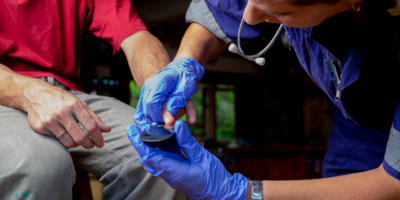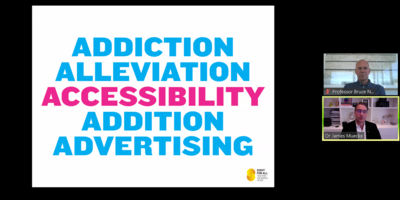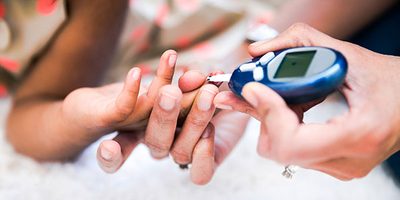
Australia’s war on type 2 diabetes
Authored by Dr James Muecke AM, 2020 Australian of the Year.
In Australia, it’s estimated that 1.7 million people are living with type 2 diabetes (T2D). It’s one of the greatest threats to our health system and shows no signs of slowing down. The George Institute for Global Health invited Dr James Muecke, 2020 Australian of the Year to comment. In this piece, Dr Muecke says people, industry and government all have a role to play in tackling this burden.
Neil Hansell is a typical Aussie. He is married with four children, constructs light machinery for a living, and in his spare time coaches javelin.
But a few years ago, Neil’s world changed overnight. He went to sleep one evening with normal eyesight. He woke up the next morning blind in both eyes.
At the age of 50, Neil was faced with spending the rest of his life in darkness. He lost his driving licence, his independence, and his ability to see the beautiful smiles on the faces of his family.
Neil had not been paying attention to his health over the years and lost his sight due to type 2 diabetes (T2D).
Unfortunately, Neil is not alone – millions of Australians have found themselves facing the devastating consequences of T2D.
But there is still hope that we can do something about it.
T2D and ancient survival mechanisms
The increasing intake of cheap and highly processed foods, supplemented by an explosion in the consumption of sugar-sweetened beverages and coupled with a more sedentary lifestyle, has been catastrophic to our health. For example, in the decade leading to 2017, there was a 30% increase in the consumption of sugary drinks in Australia.
The problem is, humans are physiologically hardwired to love and seek out sweet things. It’s an ancient survival mechanism that evolved to prepare our bodies for expected periods of fasting when food supplies were scarce.
These days, sugar is cheap and sweet products are everywhere. Prior to the 1600s, sugar was an expensive commodity. Its rising availability and popularity over the next three centuries, as a result of the booming sugar trade, led to diminishing costs. This turned sugar from a luxury item into an everyday necessity.
Sugar is highly addictive. In fact, sugar has been proven to be as addictive as the nicotine in cigarettes. Like nicotine, alcohol and drugs, the consumption of sugar activates the reward centre in our brains, resulting in the release of the neurotransmitter dopamine, which makes us feel good. But the more sugar we ingest, the more we need to make us feel good. It’s a vicious cycle that’s hard to break and often drives excessive and sustained consumption of sugar.
The ‘Five A’s’ of sugar toxicity
So, the prevention of T2D sounds simple right? Reduce consumption and people won’t get sick. Unfortunately, things are much more complicated.
Ultimately, it’s not impossible to kick the toxic impact of sugar. With a team approach and calls on resilience and innovation, there are strategies that can be employed at a personal level, and strategies that must be taken at the business, industry and government levels to tackle the ‘Five A’s’ of sugar toxicity: addiction, alleviation, accessibility, addition, and advertising.
At a personal level, it’s a matter of being aware of our own ‘addiction’ to sugar and slowly winding down from it. Our love affair with sugar is exacerbated by the strategic placement and relentless barrage of advertising of sweet products that flood our every waking moment, often in a predatory manner, and the lure of fast and convenient foods in our busy lives. Avoidance of environmental cues that trigger addictive thoughts and feelings is critical to support recovery from any addiction, including detoxing from sugar.
From a public health perspective, the government must play a pivotal role. A multi-disciplinary think tank is needed - one that engages medical doctors, neuroscientists, nutritionists, marketers, public relation experts, and government representatives. Strategies at this level should be aimed at the ‘accessibility’, ‘addition’ and ‘advertising’ A’s of sugar toxicity. Ultimately, it’s about accountability, by business, industry and government.
Strategies to tackle excessive sugar consumption
A more transparent and graphic labelling system for the amount of added sugar and applying a levy to products containing high levels of added sugar needs to be seriously considered. Sugar sweetened beverages have been linked to the development of T2D, and there’s strong, increasing and consistent evidence that a levy will effectively reduce consumption.
Advertising time and space for sugary products should be minimised, as we have done for cigarettes, starting with the cessation of such advertisements targeting children on the internet and free-to-air TV. Advertisements promoting such products should also be removed from government facilities and services such as trams and buses. Powerful and hard-hitting multi-media awareness strategies should be introduced.
The sugar industry and the food and beverage industries will need to be included in the discussions, however we cannot let commercial interests stop us from actions to prevent T2D in children, young people and the community in general.
The T2D epidemic is the biggest health challenge facing our country, and indeed the world. Australia needs to adopt a proactive and holistic approach to declare war on T2D, starting today. It is about saving our sight and saving our lives to make certain the story of Neil is never repeated for anyone in the future.




